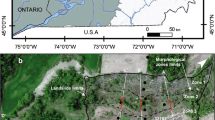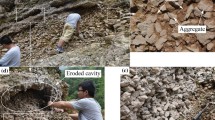Abstract
The high degree of scientific cross-fertilisation possible between the three geo-engineering disciplines soil mechanics, rock mechanics and engineering geology, is demonstrated by means of a micro-mechanical model of the Opalinus Clay. After a brief review of Terzaghi’s effective stress principle and the importance of micro-mechanical models in general, a conceptual study of a micro-mechanical model of a claystone is presented in some detail. The model is based on the Particle Flow Code (PFC) developed by Itasca Corp. It introduces into the model the pertinent composition and structure of the Opalinus Claystone established in the local engineering geology of Switzerland and SW Germany. This includes elongated clay platelets, various layers of densified water around the platelets, free water in the pores and a specific texture of the platelets after consolidation. The model is numerically subjected to a series of loading stages. It is shown that the micro-mechanical model reproduces a number of features which have been known for a long time in soil and rock mechanics but which are often intractable in conventional generic models. The features include non-linear stress–strain curves with pre-failure damage and post-failure strain softening, a non-linear increase of the particle contacts with loading, distinct clustering of deformations, clustering of micro cracks leading to the development of shear bands and hysteresis in cyclic loading. It is concluded that micro-mechanical models are promising tools for further development of our understanding of the mechanical behaviour of geological materials. They offer an excellent opportunity for scientific co-operation between engineering geologists and soil and rock mechanics engineers.
Résumé
Les possibilités de synergie entre les trois disciplines relevant de la géo-ingénierie, c’est-à-dire la mécanique des sols, la mécanique des roches et la géologie de l’ingénieur, sont illustrées au travers de l’élaboration d’un modèle micro-mécanique de l’argile à Opalinus. Après un bref rappel sur la relation de Terzaghi et sur l’importance des modèles micro-mécaniques en général, une étude conceptuelle d’un modèle micro-mécanique de roche argileuse est présentée en détail. Le modèle est basé sur le Code PFC (Particle Flow Code) développé par Itasca. Le modèle prend en compte la composition et la structure de l’argile à Opalinus, bien définies par les études de géologie de l’ingénieur réalisées en Suisse et en Allemagne. Le matériau se présente en plaquettes argileuses allongées, avec diverses couches d’eau adsorbées en surface des plaquettes, de l’eau libre dans les pores et une texture spécifique après consolidation. Le modèle numérique permet de tester les effets de divers chargements mécaniques. On montre que le modèle micro-mécanique permet de rendre compte de plusieurs caractéristiques connues de longue date en mécanique des sols et des roches mais difficiles à reproduire par les modèles conventionnels. Ces caractéristiques concernent les courbes non-linéaires contrainte-déformation, avec endommagement de pré-rupture et radoucissement de post-rupture, l’augmentation non-linéaire des points de contact entre particules en réponse au chargement mécanique, la formation de micro-fissures en amas conduisant au développement de bandes de cisaillement et les phénomènes d’hystérésis en réponse à des chargements cycliques. On conclut que les modèles micro-mécaniques représentent des outils prometteurs pour une meilleure compréhension du comportement mécanique des matériaux géologiques. Ils offrent aux scientifiques, spécialistes de géologie de l’ingénieur, de mécanique des sols et des roches, une excellente opportunité de coopération.
















Similar content being viewed by others
References
Bock H (2001) RA experiment rock mechanics analyses and synthesis: conceptual model of the Opalinus Clay. Mont Terri Technical Report TR 2001-03, pp 1–25
Bühler Ch (2000) DM experiment. Long-term dilatometer measurement. Mont Terri Technical Note TN 99-03, pp 1–16
Burman BC (1971) A numerical approach to the mechanics of discontinua. PhD Thesis, James Cook University, 383p
Cundall PA (1971) The measurement of analysis of acceleration in rock slopes. PhD Thesis, Imperial College of Science and Technology
Feeser V (1986) Geomechanical concept of the development of the fabric and stress history of glacially deformed clays (in German). PhD Thesis, Technical University, 127p
Glasstone S, Laidler K, Eyring H (1941) The theory of rate processes. Wiley, New York, pp 465
Goodman RE, Taylor RL, Brekke TL (1968) A model for the mechanics of jointed rock. J Soil Mech Found Eng Div ASCE 94:637–659
Horseman ST, Higgo JJW, Alexander J, Harrington JF (1996) Water, gas and solute movement through argillaceous media. NEA Rep CC-96/1, Paris (OECD)
Itasca (1999) PFC2D Manual (Version 2.0). Itasca Consulting Group, Minneapolis
Konietzky H (ed) (2003) Numerical modeling in micromechanics via particle methods. In: Proceedings of 1st international PFC symposium, 6–8 Nov 2002, Gelsenkirchen, Germany. Balkema, Rotterdam, 321p
Konietzky H, Blümling P, teKamp L (2003) Opalinuston—Felsmechanische Untersuchungen. Int Bericht 03–08, Wettingen (Nagra), pp 1–119
Kuhn MR (1987) Micromechanical aspects of soil creep. PhD Thesis, University of California, 185p
Matsui T, Ivo T, Mitchel JK, Abe N (1980) Microscopic study of shear mechanisms in soils. J Geotech Eng Div ASCE 106:GT2, 137–152
Mitchell JK (1976) Fundamentals of soil behavior. Wiley, New York, pp 422
Müller WH, Naef H, Graf HR (2002) Geologische Entwicklung der Nordschweiz, Neotektonik und Langzeitszenarien Zürcher Weinland. Nagra Tech Ber 99–08, pp 1–237
Nagra (2001) Sondierbohrung Benken, Untersuchungsbericht. Nagra Techn Rep 00-01, Text- und Beilagenband, pp 1–288
Nagra (2002) Project Opalinus Clay. Safety Report. Demonstration of disposal feasibility for spent fuel, vitrified high-level waste and long-lived intermediate-level waste (Entsorgungsnachweis). Nagra Techn Rep 02–05, pp 1–360
Nüesch R (1991) Das mechanische Verhalten von Opalinuston. Mitt Geol Inst ETH Univ Zurich N F 293:1–244
Oda M, Iwashita K (1999) Mechanics of granular materials. Balkema, Lisse
Shimizu Y, Hart R, Cundall P (eds) (2004) Numerical modeling in micromechanics via particle methods. In: Proceedings of 2nd international PFC symposium 28–29 Oct 2004, Balkema, Rotterdam, 435p
Terzaghi Kv (1925) Erdbaumechanik auf bodenphysikalischer Grundlage. Deuticke, Wien, p 399
Trollope DH (1968) The mechanics of discontiunua or clastic mechanics in rock problems. In: Stagg KG, Zienkiewicz OC (eds) Rock mechanics in engineering practice, Chapter 9. Wiley, London, pp 275–320
Author information
Authors and Affiliations
Corresponding author
Rights and permissions
About this article
Cite this article
Bock, H., Blümling, P. & Konietzky, H. Study of the micro-mechanical behaviour of the Opalinus Clay: an example of co-operation across the ground engineering disciplines. Bull Eng Geol Environ 65, 195–207 (2006). https://doi.org/10.1007/s10064-005-0019-9
Received:
Accepted:
Published:
Issue Date:
DOI: https://doi.org/10.1007/s10064-005-0019-9
Keywords
- Engineering geology
- Soil mechanics
- Rock mechanics
- Discrete elements
- Particle flow Code
- Opalinus Clay
- Micro-mechanical model




